Resources
Learn the language of the loom!
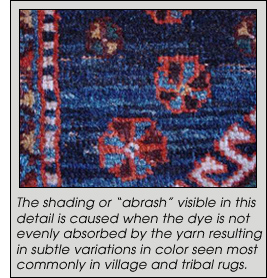
All Over Design - A repeat pattern that fully covers the field of a rug.
Arabesque - A design of intertwining vines, flowers and leaves common in Persian rugs.
Asymmetric Knot - A knot tied on two or more off-set warps; also called a Senneh or Persian knot.
Aubusson - Elegant and stylish, this French classic usually is made in muted colors with a medallion design. The name comes from a French factory in production in the 18th century.
Axminster Loom - A type of power loom used for manufacturing Oriental rug designs, because of their flexibility reproducing color and design.
Backing/Backing Material - To protect the back of tufted or hooked rugs, heavy fabric is secured with latex glue.
Bessarabian - Flat woven rugs, depicting stylized florals, of Romanian or Turkish origin.
Border - The design, which forms the outside edge of a rug and surrounds the field.
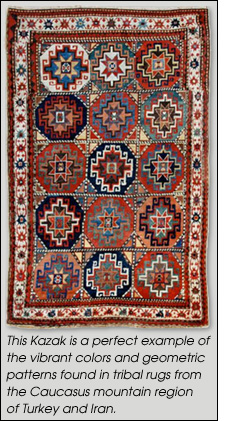
Cartoon - A colored drawing on graph paper of the rug design that a weaver follows when weaving a rug. Each square on the cartoon represents a single knot.
Carving - Hand-held carving tools are used to accentuate details of hooked, tufted and hand knotted rugs.
Caucasian - A generic name describing boldly colored geometric designs originating from Armenia, Azerbaijan, and other areas in the Causcasus mountain region.
Chemical Wash - Produces an overall lustre by reacting to the dyestuffs in the wool and by removing some of the wool scales from the pile.
Chrome Dyes - A high quality synthetic dye that uses potassium bichromate to form a permanent bond between the dye and the wool fiber.
City Rugs - Rugs that are produced in large metropolitan areas. City rugs are usually curvilinear and have a higher knot count than tribal rugs. Consistency in color, design, material, and weave determine the value in these rugs.
Cross-woven - This refers to a rug woven horizontally on a Wilton loom as opposed to vertically, which is more common.
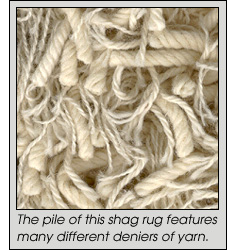
Density - This measure of quality is determined by the amount of yarn and the pile height in a given area in a power-loomed rug and the knot count in a hand knotted rug.
Dhurrie - Hand made flat weave from India, usually of muted colors in wool or cotton and very popular in the 80's.
Edge Wrap - The side of the rug is wrapped with thick yarn to secure the outer edges. This should be done during the weaving process.
Field - The part of a rug's design surrounded by the border. The field may be solid or contain medallions, or an overall pattern.
Foundation - The combination of warps and wefts in the body of a rug, usually made with cotton but also seen in wool and/or silk.
Hooked Rug - Rugs made when yarns are pushed through a canvas cloth, then latex glued on the back side to hold the yarns in place.
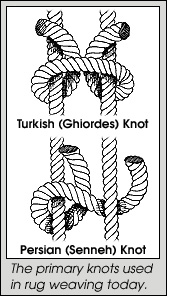
Kilim - Flat woven like a dhurrie, but usually in richer colors Kilims are extremely versatile. Kilims were used by weavers themselves in everyday life and are rich with cultural motifs. Utilitarian in origin, they're used for carrying and storing supplies.
Knot - Each yarn is tied around 2 or more warp cords to form a single knot. The number of knots per square inch is one of the quality factors in an Oriental rug.
Lines - Most hand knotted Chinese rugs are graded by line count, which indicates the number of knots per linear foot.
Medallion - If a design has a noticeable center motif, usually circular or star-shaped, it is called a center medallion.
Nap - Rugs have nap direction caused by the knotting direction. Due to light reflection, a knotted rug will look light at one end and dark from the other end. In older rugs, traffic patterns can cause nap distortion that can change the original nap direction.
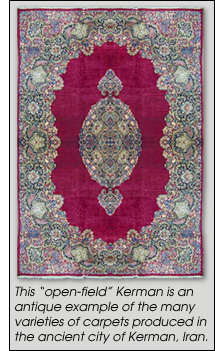
Persian - Persia encompasses an area larger than current day Iran, which includes parts of India, Afghanistan and Iraq, as well as groups of Nomadic people.
Pile - The cumulative cut ends of the knot result in a pile or face of the rug. Most rugs have wool pile, which some have silk or a combination of silk and wool pile. Pile is sometimes called the "nap".
Pile Height - The height of face yarns from the backing to the tip of the piece of yarn.
Ply - One or more yarns are twisted together to form a larger piece of yarn. Ply counts the number of individual yarn pieces comprising the whole.
Polypropylene - A synthetic fiber that is colorfast, mold and mildew resistant, stain resistant, with excellent wearability and is easily cleaned. Commonly replaces wool in power loomed rugs.
Power Loomed - Rugs that are "machine made" rather than hand knotted or hand tufted.
Raj - Iranian rugs use a knot count based upon raj. This is the number of linear knots in 7cm. A raj is actually the length of an unfiltered cigarette used as a uniform measure.
Root names - When Persian designs are produced in China the word "Sino" precedes the name of the design e.g.: Sino-Persian. If a Kerman design is produced in India it is called Indo-Kerman.
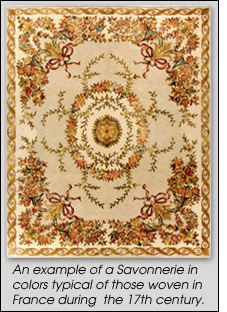
Staple - The average length of fibers in the wool.
Symmetric Knot - A knot tied on two or more parallel warps; also called a Ghiordes or Turkish knot.
Tribal - Handmade in villages or by nomadic tribes, these rugs - from Iran, Turkey, Afghanistan and the Caucasus - feature bold, geometric designs and are usually coarsely woven. Many tribal rugs are made of a wool warp and weft, unlike city rugs made with a cotton warp.
Tufting - Yarns are pushed through a cotton canvas to form a pattern with a hand held tufting gun. Then, latex is applied to hold the yarns in place after which a backing is applied.
Variegated - Using multiple colors.
Vegetable Dyes (also Vegetal dyes) - Natural dyes produced from berries, roots, insects, bark, and other natural sources. They are not as consistent as chrome dyes, but can produce wonderfully rich or subtle shades that have an organic feel not easily reproduced by synthetic dyes.
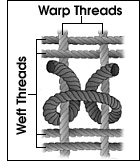
Weft - Horizontal threads are placed between warp threads after a row of knots is tied securing the knots. The number of weft threads between each row of know varies by region.
Wilton Loom - A type of automated loom popular for producing Oriental designed power loomed rugs and carpet.
Worsted - Before wool is spun into yarn, it is combed, and then twisted to improve its quality by leaving only longer pieces of fiber for final spinning.
These books will help you increase your knowledge and love your Hagopian rug even more!
Baluchi Woven Treasures by Jeff W. Boucher & James Opie
Book of Oriental Carpets and Rugs by Ian Bennett
Carpets, From the Tents, Cottages and Workshops of Asia by Jon Thompson
Caucasian Carpets by E. Gans-Ruedin
Caucasian Rugs by Ulrich Schurmann
Chinese and Exotic Rugs by Murray L. Eiland
Complete Illustrated Rugs and Carpets of the World by Ian Bennett
Indian Carpets by E. Gans-Ruedin
Oriental Carpet Design: A Guide to Traditional Motifs, Patterns and Symbols by P.R.J. Ford
Oriental Carpet Identifier by Ian Bennett
Oriental Carpets by Jon Thompson
Oriental Rug Primer: Buying and Understanding New Oriental Rugs by Ian Bennett
Oriental Rugs, Antique and Modern by Walter Hawley
Oriental Rugs, Caucasian by Ian Bennett
Oriental Rugs: The Collector's Guide to Selecting, Identifying and Enjoying New and Antique Oriental Rugs by George O'Bannon
Oriental Rugs - Vol 1 by Ian Bennett
Oriental Rugs - Vol 2 by Erich Achenbrenner
Oriental Rugs - Vol 3 by R.D. Parsons
Oriental Rugs - Vol 4 by K. Zipper
Oriental Rugs - Vol 5 by U.W.E. Jourdan
The Connoisseur's Guide to Oriental Rugs by E. Gans-Ruedin
The Oriental Carpet by P.R.J. Ford
The Persian Carpet by A. Cecil Edwards
The Turkoman Carpet by George O'Bannon
Tribal Rugs: A Complete Guide to Nomadic and Village Carpets by James Opie
Tribal Rugs: A Complete Guide by Murray Eiland Jr. & Murray Eiland III
Tribal Rugs by James Opie
Turkmen: Tribal Carpets and Traditions by Louise Mackie & Jon Thompson
Shipping- Online Orders
All orders are processed for shipping the next business day. Orders received after 10am on Friday will be processed the following Monday.
There is no charge for shipping within the contiguous United States using standard UPS. Pads that are 5' x 8' or smaller can be rolled with the rug and will be combined with the rug as a single item. There is an extra shipping charge to Alaska, Hawaii, Canada, and/or for rugs that are too large to ship standard UPS. If your order needs to be sent by a common carrier freight company we will contact you with specific delivery instructions and to notify you of the additional cost.
A signature will be required when your rug is delivered, so you may wish to have your rug shipped to your place of work. It is very important that you inspect your package(s) at the time of delivery. If there is any damage please make sure that the driver notes that the package is damaged in their electronic log, or refuse delivery if the rug itself appears damaged. In either case contact us immediately.
Rugs are rolled tightly for shipping purposes. Some rugs may need 24-48 hours to completely “relax” (depending on humidity) after they are unrolled.
Returns
Rugs may be returned within 14 days for a full refund. Rugs must be returned in as-new condition - unused, clean and undamaged.
Option 1: In-Store Returns - Simply bring the rug back with your receipt to any of our showrooms within 14 days for a full refund, or within 30 days for an exchange or store credit.
Option 2: Shipped Returns - Please contact us at returns@originalhagopian.com to secure your return authorization (RA) and to request shipping packaging when the original packaging your rug came in is not available. Make sure your RA number is written clearly on the exterior of the package, we will be unable to accept any rugs without an RA number and they will be returned to sender.
Ship returns to:
Hagopian World of Rugs
14050 W 8 Mile Rd.
Bay 8
Oak Park, MI 48237
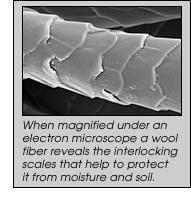 The fineness of wool is determined by the amount of crimp (number of bends per unit length along the wool fiber). Wools with the highest amount of crimp are used exclusively for fine clothing like men’s suits, coarser types of wool with less crimp are reserved for rugs and carpets. Because of this crimp, wool produces a bulkier fiber that traps air and is more insulating resulting in greater heat retention. When used in flooring wool significantly reduces heat-loss through the floor. This insulation works both ways and some desert tribes actually use wool garments to help keep the heat out.
The fineness of wool is determined by the amount of crimp (number of bends per unit length along the wool fiber). Wools with the highest amount of crimp are used exclusively for fine clothing like men’s suits, coarser types of wool with less crimp are reserved for rugs and carpets. Because of this crimp, wool produces a bulkier fiber that traps air and is more insulating resulting in greater heat retention. When used in flooring wool significantly reduces heat-loss through the floor. This insulation works both ways and some desert tribes actually use wool garments to help keep the heat out.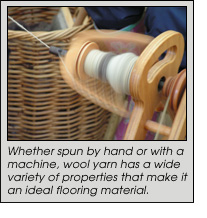 Of course one of wool's greatest benefits is that it is a renewable resource and biodegradable. Sheep are shorn once a year, usually in the spring, to produce anywhere from 2 to 30 pounds of wool per animal depending on the breed. While sheep are raised all over the world, those raised in more temperate, less arid climates, and especially those raised at higher altitudes produce the best wool for flooring production. This is because sheep that are raised in cooler climates develop a higher lanolin content in their wool which make the fibers not only stronger, but more insulating and with a natural built-in resistance to soil and dirt. This makes wool from New Zealand, the British Isles and the Himalayas especially prized for rug weaving.
Of course one of wool's greatest benefits is that it is a renewable resource and biodegradable. Sheep are shorn once a year, usually in the spring, to produce anywhere from 2 to 30 pounds of wool per animal depending on the breed. While sheep are raised all over the world, those raised in more temperate, less arid climates, and especially those raised at higher altitudes produce the best wool for flooring production. This is because sheep that are raised in cooler climates develop a higher lanolin content in their wool which make the fibers not only stronger, but more insulating and with a natural built-in resistance to soil and dirt. This makes wool from New Zealand, the British Isles and the Himalayas especially prized for rug weaving.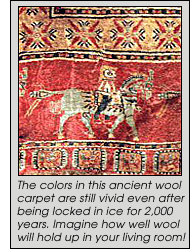
Perhaps the greatest testament to wool's durability and excellent suitability as a rug & carpet fiber is the Pazyryk carpet (right) discovered frozen in the tomb of a Scythian prince in the Altai Valley of Siberia in 1949. Radiocarbon testing demonstrated that the carpet was woven in the 5th century B.C. and yet it remains largely intact with it's colors only somewhat diminished by it's great age. Perhaps even more astounding, the Pazyryk carpet boasts 232 knots per square inch, making this over 2,000 year old carpet similar in quality to rugs being woven today!
Wool truly is a wonder fiber. Naturally resistant to dirt, fire, mildew and static electricity, wonderfully insulating, sound absorbent, biodegradable and environmentally friendly in it's production and among it's many other beneficial properties it is also extremely durable and can stand up to even the test of time! What more could you ask for in a fiber for your next rug or carpet purchase?
|
For more information on the wonder of wool please see: |
||
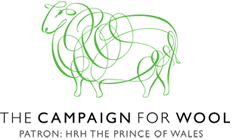 |
 |
|
